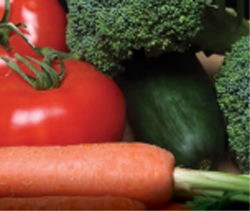Little Green Machines
Reminders about the loving Creator are all around us, even in the grass we walk on.
Day after day, these little green machines faithfully convert sunlight into energy for all living things to use. God’s provision is so commonplace, that we don’t even think about it.
Summer breezes rustling the leaves, soft grass tickling bare feet, ripe grapes bursting on the vine, sunflowers dancing in the garden. These are just a few of the things we enjoy about the diverse plants that God gave us. But plants do so much more behind the scenes that we take for granted. Without plants, life as we know it could not exist.
The ability of plants to produce food from the sun is one of the most important and complex biological processes known to scientists.
The energy source that powers life is the sun. The problem is that the sun’s energy comes to us in a form we can’t use. So we depend on earth’s “green things” to help us (Job 39:8).
God programmed these amazing little machines to work nonstop, supplying practically all living things with the energy they need. We, as well as animals, get our energy from them: leaves, seeds, nuts, fruits, flowers, and other tasty parts. Indirectly, we get energy from plant-eaters. If plants did not have this energy-harnessing capability, we would all die.
The ability of plants to produce food from the sun (photosynthesis) is one of the most important and complex biological processes known to scientists. Yet we rarely notice the true wonder of plants. Starting with a seemingly simple leaf, let’s reexamine the wonders we’ve all known since grade school and marvel at the beauty and detail the Creator intricately designed within them.
Leaves—Powerful Sun Catchers
Most photosynthesis takes place in the leaf. Leaves have a number of layers—each designed with a different purpose. The surface layers are the security guards, letting in the good stuff and keeping out the bad. The outside has a waxy layer, called the cuticle, which protects the inner parts of the leaf. Another clear layer of flat cells, called the epidermis, allows sunlight to enter but not escape.
Flip a leaf over, and you’ll find tiny holes, called stomata. These openings regulate the chemicals that flow in and out. Specially designed guard cells know how to recognize different molecules, and they tell the stomata when to open and close depending on whether it’s time for carbon dioxide to enter or water vapor and oxygen to exit.

On the underside of leaves are tiny holes called stomata (inset). These openings regulate the amount of carbon dioxide entering and the amount of water vapor and oxygen exiting. Copyright 2008 Jupiterimages Corporation.
Inside the Plant Cell
Take any section of a leaf and put it under a microscope. You’ll find an amazing collection of tiny factories and machines. First you encounter little green egg-shaped bodies, called chloroplasts. Their job is to convert light to chemical energy to make sugar. Each of these “eggs” is a complete factory in itself. A single cell can have dozens of these factories.
As you magnify a chloroplast, you find the chlorophyll itself—a tiny, complex molecule made of many different atoms. These atoms fall into just the right sequence and fold together in just the right order to respond to each incoming ray of light, the first step in the plant’s miraculous manufacturing process.
Photosynthesis—A Manufacturing Process Like None Other

Copyright 2008 Jupiterimages Corporation.
A Cornucopia of Uses
Although plants use the same basic machinery to convert sunlight into food, no two plants are the same. By God’s design, we have more than just spinach or lettuce or broccoli to eat (though He could have limited our diet to these). No, plants take all sorts of forms. The Creator filled the earth with an unimaginable variety and abundance of foods, from cocoa to mint, wheat, and watermelon. He thought of all these flavors and every combination of flavors, which our best chefs are only now beginning to discover. He did this because He loves to bless us. He boasts that at His right hand “are pleasures forevermore” (Psalm 16:11) and He “satisfies your mouth with good things” (Psalm 103:5).
Besides producing food, God designed plants to fill many other essential roles. They provide shelter for animals, fire for heating, and material for designing homes and clothes. They give us medicines, glues, and chewing gum. Perhaps more importantly, their constantly changing colors give us a visual feast that reminds us of God’s beauty.
Each day, we are surrounded by evidence of a caring Creator who abundantly provides for our physical and emotional needs through these marvelous little green machines. No wonder Jesus Christ pointed to a field of lilies and told His followers they had no reason to worry: “Solomon in all his glory was not arrayed like one of these. . . . [Shall God] not much more clothe you?” (Matthew 6:29–30).
Let’s take a brief look at the photosynthesis process. Hundreds of chemical reactions take place in perfect sequence, like a production line in a well-organized factory.
As chlorophyll panels absorb light, they vibrate feverishly, spewing out energized electrons. Then conveyor belts and pumps, made out of proteins, compress the energized electrons into tiny “batteries.”
Next, small “carts” made out of molecules transport these batteries to the “carbon-stitching machines” made out of enzymes and organic acids. These machines use the power in the batteries to take carbon from the air (carbon dioxide, or CO2) and bind it into sugar and starch, the source of energy in the foods we eat.
The Nucleus—A Machine-Making Machine
Chloroplasts could not function alone. They need all sorts of other factories and machinery to support them. At the center of each cell, for example, is a nucleus (see the plant cell below). This serves as the administration and technology center of the cell. Here all the information to run the cell is stored in the form of DNA.
Layers of membranes surround the nucleus. Their job is to manufacture the parts that other machines need in the cell. These layers don’t just make complex molecules out of proteins and sugars. They break off and transport these molecules, like conveyer belts, to areas of the cell where they are needed.
As we travel around the cell, we discover brown, bean-shaped bodies (mitochondria). Each of these “beans” converts the sugar made in chloroplasts into another form of energy that the rest of the cell can use.
All these factories and machines are suspended in a jelly-like fluid, called protoplasm. This jelly is constantly rotating, and yet all the parts stay in communication with each other and know where to go. The protoplasm and other cell parts remain close to the wall, pushed there by a large “waste bag” (the vacuole) that fills most of the cell. This bag is filled with water and dissolved “trash” that is left over from the manufacturing.
Not all the “wastes” go into the “waste bag.” Oxygen and water vapor, for instance, are released through the stomata into the atmosphere to be used by humans and animals. If only manmade machinery produced “wastes” like this!

Related Videos
Plants
Answers Magazine
July – September 2008
In this issue discover the wonders of God’s creation and see how our Creator is clearly seen all around us. Articles cover bizarre creatures in the fossil record, the intricate “matrix” of bacteria, the eye, and many other marvels.
Browse IssueRecommended Resources

Answers in Genesis is an apologetics ministry, dedicated to helping Christians defend their faith and proclaim the good news of Jesus Christ.
- Customer Service 800.778.3390
- Available Monday–Friday | 9 AM–5 PM ET
- © 2025 Answers in Genesis





